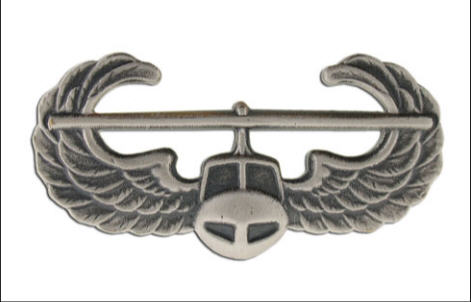Tactics 101 041 – The Landing Plan
The Landing Plan
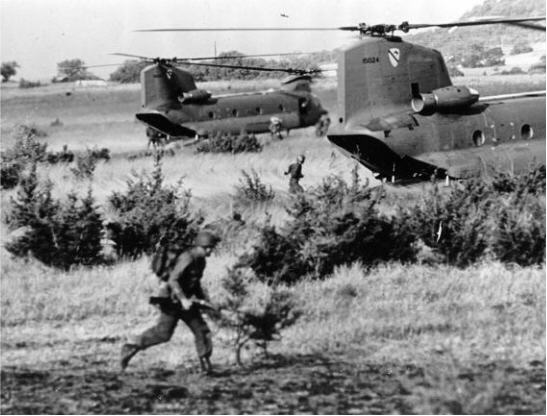
"There is no type of human endeavor where it is so important that the leader understands all phases of his job as that of the profession of arms." – Major General James Fry
LAST MONTH
In our last article, we began focusing on the five nested sub-plans of conducting an air assault operation. Using backwards planning, we started with the Ground Tactical Plan (GTP). Clearly, everything we do in planning for an air assault sets the conditions for getting your Soldiers at the right place at the right time (the GTP).
In our discussion last month we keyed on answering the following questions: 1) What is the GTP? 2) How do we define the objective for the GTP? 3) What are the factors in Landing Zone (LZ) selection? 4) What are the GTP planning factors? 5) What are some of the key missions for air assault forces once they are on the ground? 6) How do you best utilize your assets in the GTP? and 7) How do you best consolidate and reorganize your forces within the GTP.
We are aware that it was a fairly detailed article. However, as you gleaned there is much to consider in not only the overall air assault plan, but in each sub-plan. We will continue this detail in each subsequent article involving the sub-plans.
THIS MONTH
As we continue to backwards plan we move to the next step—the landing plan. The landing plan is designed in support of the ground tactical plan. It sequences tactical units into the objective area at the right time and place in order for them to accomplish their assigned task and purpose. A brilliant Ground Tactical Plan will fail if the Landing Plan is poorly conceived. The critical components of the landing plan are:
– Sequencing
– Timing
– Location
This article will focus on areas related to these critical components of the landing plan.
INTRODUCTION – (OBLIGATORY WAR STORY)
My first mission as a Pathfinder Team Leader came at Pathfinder School at Fort Benning, Georgia, in the summer of 1987. We jumped into a postage sized DZ and headed off to find the proposed Helicopter Landing Zone (HLZ). We hiked over hill and dale to find the site (I was young back then, so I did not mind!). I knew my mission; establish the LZ, make contact with the birds, and get them on the ground. I didn’t know who was coming, but it didn’t matter as long as the LZ was set up on time. It turned out that the LZ couldn’t handle the number of helicopters or the landing formation in the order. We took wind-speed and direction readings at ground level and altitude. We surveyed the entire LZ and determined the land heading and selected a new formation that would use the available space most effectively. I was an aspiring Pathfinder learning a new skill and my role in the operation was pretty narrow. In later years, I would understand that this was the culmination of the Landing Plan—one of the five plans required to execute an air assault.
YOU MAY (NO YOU MUST) CONSIDER THE FOLLOWING:
There are numerous considerations to take into account when developing the landing plan. We discussed the first one (LZ selection) during our discussion on the ground tactical plan—that’s because the five air assault plans overlap. This means that the planner must make assumptions about the landing plan in order to complete the ground tactical plan.
First you must consider the availability, location, and size of potential landing zones (LZ’s) as the dominant issue. Next, consider the vulnerability of the Air Assault Task Force (AATF) as the helicopters land. The aircraft must deliver units that contain tactical integrity. The troops in each bird must be kept up to date as to direction, orientation, and map location in order to reduce disorientation.
Part of the landing plan must take into account the requirement to fight in any and all directions upon landing. The plan must be flexible enough to provide a variety of options to reinforce the developing situation. Supporting fires (artillery, naval gunfire, CAS, attack helicopters) must be planned in and around each LZ. Although the objective may be beyond the range of supporting artillery fire, artillery or mortars may be brought into the landing zone(s) early to provide fire support for subsequent lifts and on the objective.
Lastly, the plan should include provisions for enroute combat search and rescue (CSAR) to recover crews and loads of aircraft downed in flight; provide re-supply; and provide air medical evacuation (MEDEVAC).
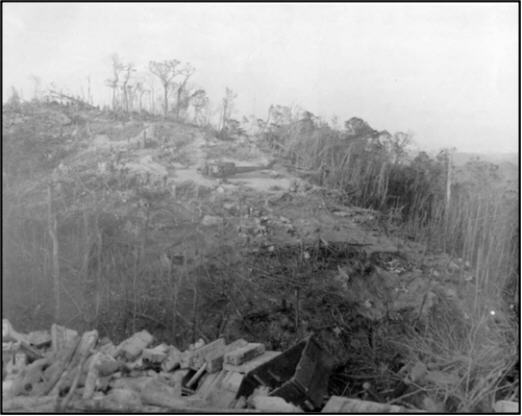
Selection of landing zones. Landing zones are selected by the Commander or operations officer with technical advice from the Air Mission Commander (AMC) or his liaison officer (LNO). Selection considers whether the LZ is on, near, or away from the objective. The area’s capacity to handle aircraft is considered since this determines how much combat power can be landed at one time. This also determines the need for additional LZ’s or timing separation between insertions. Alternate LZ’s should be planned for each primary LZ for flexibility.
Enemy disposition and capabilities. Enemy troop concentrations, air defenses, and their capability to react to a landing are considered in LZ selection. The more responsive the enemy reaction; the more fire support is required or the father away the LZ must be in order to allow combat power to build. Cover and concealment must be adequate enough to deny enemy observation that might direct fires against the Air Assault Task Force (AATF) enroute and landing. Enemy obstacles must be templated and found where possible and the AATF should land on the enemy side when attacking. The AATF tries to use natural and hasty man-made obstacles to protect LZs from enemy attack. The LZ itself must be free of obstacles and the approach and departure routes should avoid flank exposure to the enemy weapons systems.
Identification from the air. The LZ needs to be readily identifiable from the air. Although the pilots are looking for the landing zone, it’s not their responsibility to put the troops where they belong. The Infantry leaders in the lift need to ‘flight follow’ in order to know where they are and need to be able to confirm that the LZ the pilots find is the right one. The LZ should be marked with chemical lights or strobe lights, preferably infrared during night ops and colored smoke or orange VS17 panels in daylight. This assumes the presence of a Pathfinder unit or friendly reconnaissance to mark the LZ.
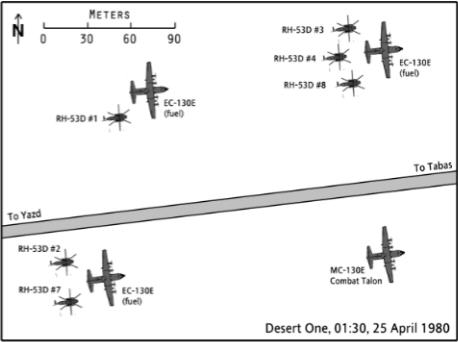
Obviously weather conditions are critical. High wind-speed, excessive heat, humidity, and even altitude effect visibility and Allowable Cargo Load (ACL). DESERT ONE was critically hampered by the heat and a deadly sandstorm. The combined effect was to significantly degrade helicopter performance and hinder navigation. The conditions in Afghanistan have made the only truly effective Helicopter the CH47 Chinook This is because of its’ ability to function in the high altitude and thin air of the Hindu Kush.
When LZ options are available, the planner emphasizes the characteristics that maximize mission accomplishment. The relevant factors are:
Combat power. This includes maneuver elements, firepower, and combat support assets that should be introduced early in the operation. Troops and artillery will probably go in on separate LZ’s and the artillery may support from distant LZ’s that they can occupy and fire from. The amount of combat power that can insert early is dependent upon the number of aircraft available and access to suitable LZ’s.
Enemy. This includes enemy disposition, composition and strength in and around the LZ’s and the objective. Special attention is given to air defense systems from Small Arms Fire for Air Defense (SAFADS) to shoulder fired man portable air defense and radar guided anti air missiles and guns. These will be targeted by the suppression of enemy air defenses (SEAD) sub-plan of the air movement plan.
Surprise. Surprise is always a good thing (unless you are on the receiving end). It can be attained many ways. The AATF need not mask the landing, an incredible difficult task on the modern battlefield. Surprise can be attained by executing false insertions while enroute to the objective LZ. A false insertion is similar to a ‘touch and go’ where the aircraft sets down long enough to appear to be landing, but doesn’t put troops out. The enemy sees the helicopters descend onto an open area then lift off as if troops had been inserted. Surprise can be achieved through skillful use of terrain, cover and concealment, darkness, or reduced visibility created by weather or smoke.
Time. The time available for mission accomplishment is especially critical when executing air assault operations. The less time available, the closer you must land to the objective.
TYPES OF LZs
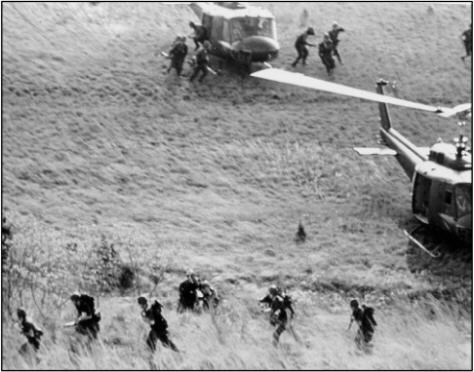
Should you use one LZ or many? This is a critical question loaded with consequences. Let’s look at each below.
The Single LZ
A single LZ allows the concentration of combat power in a single location. If the LZ is large enough, the build-up will be rapid as well. It facilitates maximum control of operations. LZ X-Ray allowed Hal Moore to rapidly shift his battalion in order to meet NVA attacks from all directions. Although the LZ was too close to the enemy, the fact that operations emanated from a single point gave General Moore the flexibility to rapidly respond to enemy maneuver.
A single LZ also allows the concentration of supporting fires in and around the LZ—another positive aspect of LZ X-Ray. It is easier to secure for the initial and subsequent lifts. A single LZ requires fewer attack helicopters for security and reduces the number of flight routes to the objective area. This makes it more difficult for enemy scouts to detect the air assault.
Lastly, the use of a single LZ centralizes any resupply operations and MEDEVAC. A single LZ concentrates LZ control personnel and engineers on one LZ and takes less time to plan and rehearsal.
Multiple LZs.
There are many advantages to a single LZ, but this option is difficult to pull off for large scale missions of a battalion or more. The planner will normally have to select multiple LZ’s in order to accommodate multiple objectives and emplace fire support.
Multiple LZ’s allow the AATF to avoid massing assets in one location, thus creating a bomb magnet for enemy indirect fires. Multiple LZ’s facilitate rapid dispersal of ground elements to separate areas and separate missions—a fact that fits the main effort and supporting effort planning model. The dissipation of helicopters and forces too many locations reduces the enemy’s ability to detect and react to the initial lift. It forces the enemy to fight in more than one direction and to pursue many emerging threats. It reduces troop and aircraft congestion and makes it difficult for the enemy to determine the size and location of the air assault force and its’ supporting weapons.
NOTE: If the objective is designated by a number, the LZ should be designated by a letter or code word to avoid confusion and preclude mix-ups. This avoids having an objective (OBJ) and LZ with the same designator; for example, LZ 1 and OBJ 1.
LANDING FORMATIONS
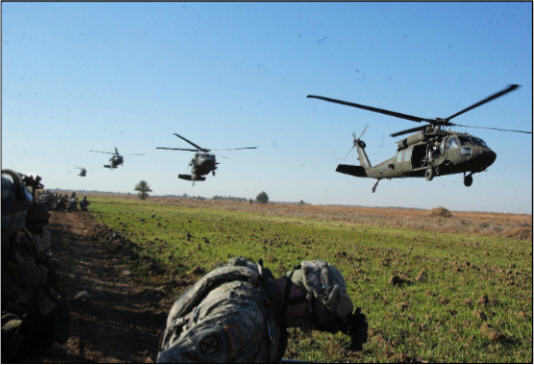
Aircraft landing formations should facilitate off-loading and deployment for the assault while maximizing the useful space on the LZ. The goal is, wherever possible, to fit as many birds—simultaneously—as possible in order to rapidly build up combat power. The number and type of aircraft; the presence of slingloads and heavy lift; and the orientation and size of the LZ dictate the formation. Let’s highlight some of these formations below.
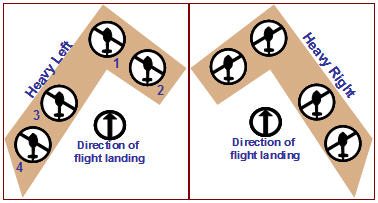
Heavy right and left facilitate numerous odd shaped landing zones and are good for offloading small units.
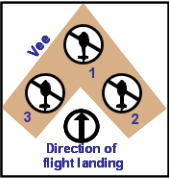
The Vee is suited for smaller LZ’s and is especially useful when inserting small reconnaissance units.
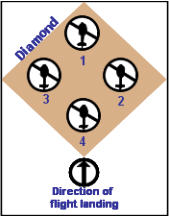
The Diamond has the same characteristics as the Vee, but requires a bit more useable space. Consequently, the diamond can offload a larger force than the Vee.

The trail is an incredibly versatile formation and can offload an unlimited number of troops based on the length of linear space available. This formation is often used to offload on roads, airstrips, wide ridgelines, or in valleys.

The Echelon right and left affords the same advantages of the trail formation and accommodates similar landing zones with varying linear angles.
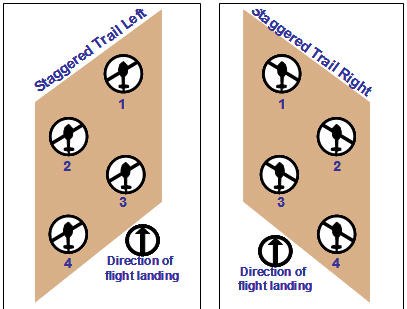
Staggered trail right and left require a decent amount of space. They are variations on the diamond and vee and allow the offload of a platoon or slightly larger element.
PLANNING GUIDELINES
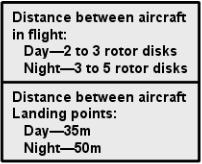
Although the above are guidelines that are published and practiced in peacetime, the landing aircraft can and should modify their landing intervals in accordance with the nature of the LZ—hot, warm, or cold.
Fires to support the landing plan.
While it may be advantageous to make the initial assault without preparatory artillery fires for the sake of surprise, prep should be planned for each LZ in the event that they are needed. Fires should be brief and intense to exploit surprise and suppress any rapid enemy response. These fires should then be lifted immediately prior to the first landing. If surprise is lost or cannot be gained given the LZ’s available then a longer prep is called for in order to reduce enemy resistance and minimize their ability to shift forces against the LZ or to reinforce the objective.
Air assault prep is not just a matter of artillery. The AATF prep should include close air support tactical aircraft and attack helicopters. Long range artillery and rockets should also be requested from higher headquarters. It also must be remembered that some artillery support may have to be flown in by sling load to LZ’s that allow them to range the main objective. Further movements may be necessary as the battle unfolds.
Just as important as the positioning of artillery and prep is target selection. What should you prep? A good place to start is known or suspected enemy positions regardless of size. As you know, it doesn’t take much to disrupt an LZ. I’ve done it with a squad hitting the first bird to touch down on one occasion and with well timed artillery on another. You may also want to fire on obstacles that would interfere with landing. For that matter, sometimes the prep may, more or less, create the LZ—the Vietnam era Daisy Cutter comes to mind. On the other hand, the effects of prep fires must not create a hindrance. Ordnance can cause craters, knock down trees, and start fires that obstruct and/or obscure the LZ.
Fires should be timed in such a manner that they will lift and/or shift in synchronization with the arrival of the aircraft formations. Fire control measures are designated to monitor lifting and/or shifting fires.
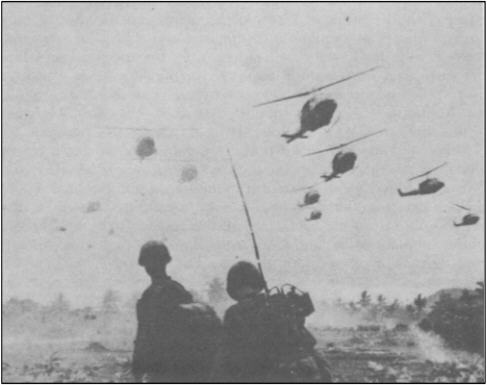
Aircraft availability.
Aircraft availability is an overriding consideration in air assault operations. It is directly influenced by the adequacy and efficiency of maintenance and supply activities, and aircraft utilization and scheduling procedures, as well as by the distance of support units from the operating units.
Both the supporting and supported commanders should be aware that everyday use, over an extended period, of all available aircraft will result in a reduced mission availability rate for future operations. During periods of sustained operations, fixed-wing aircraft normally can maintain a greater percentage of aircraft availability for longer periods than helicopters. In the course of sustained operations, aircraft maintenance must be carefully considered and programmed so that heavy flying requirements will not cause a continual decrease in aircraft availability.
Capabilities of army aircraft.
Under normal conditions, helicopters can ascend and descend at relatively steep angles, a capability which enables them to operate from confined and unimproved areas. Troops and their combat equipment can be unloaded from a helicopter hovering a short distance above the ground with troop ladders and rappelling means, or if they can hover low enough, the troops may jump to the ground. The troop ladder can also be used to load personnel when the helicopter cannot land.
Cargo can be transported as an external load and delivered to areas inaccessible to other types of aircraft or to ground transportation. Because of a wide speed range and high maneuverability at slow speeds, helicopters can fly safely and efficiently at a low altitude, using terrain and trees for cover and concealment. Their ability to fly at high or low altitudes and to decelerate rapidly, combined with their capacity for slow forward speed and nearly vertical landing, enables helicopters to operate under poor weather conditions. Helicopters flying at low levels are capable of achieving surprise, deceiving the enemy at the LZ(s), and employing shock effect through the use of suppressive fires.
Night and/or limited visibility landings and lift-offs can be made with a minimum of light. Engine and rotor noise may deceive the enemy as to the direction of approach and intended flight path.
Limitations of army aircraft.
The high fuel consumption rate of helicopters imposes limitations on range and Allowable Cargo Load (ACL). Helicopters may reduce fuel load to permit an increased ACL. However, reducing the fuel load reduces the range and flexibility factors, which must be considered in planning. Weight and balance affect flight control. Loads must be properly distributed to keep the center of gravity within allowable limits. Hail, sleet, icing, heavy rains, and gusty winds (30 knots or more) will limit or preclude use of helicopters.
Engine and rotor noise may compromise secrecy. Aviator fatigue requires greater consideration in the operation of rotary-wing aircraft than in the operation of fixed-wing aircraft. The load-carrying capability of helicopters decreases with increases of altitude, humidity, and temperature. This limitation may be compensated for through reduction of fuel load.
Crosswind velocities above 15 knots for utility and 10 knots for cargo helicopters, and downwind velocities above 5 knots for either type of helicopter, will affect the selection of the direction of landing and lift-off.
Selection and marking.
Small unit leaders should be proficient in the selection and marking of PZs and/or LZs and in the control of aircraft. Below are some keys in marking PZs and LZs.
– Day. A ground guide will mark the PZ or LZ for the lead aircraft by holding an M16Al rifle over his head, by displaying a folded VS-17 panel chest high, or by other identifiable means.
– Night. The code letter Y (inverted Y) is used to mark the landing point of the lead aircraft at night. Chemical light sticks or "beanbag" lights may be used to maintain light discipline

The Inverted Y. When more than one aircraft will be landing in the same PZ or LZ, there will be an additional light for each aircraft. For observation, utility, and attack aircraft, each additional aircraft landing point will be marked with a single light emplaced at the exact point that each aircraft is to land. For cargo aircraft (CH-47, CH-53, CH-54), each additional landing point will be marked with two lights. The two lights will be placed 10 meters apart and will be aligned in the aircraft direction of flight.
Obstacles.
These include any obstruction to flight which might interfere with aircraft operation on the ground (trees, stumps, rocks) and cannot be reduced. During daylight, the aircrew is responsible for avoiding obstacles on the PZ or LZ. For night and limited visibility operations, all obstacles will be marked with red lights. The following criteria will be used in marking obstacles:
– If the obstacle is on the aircraft approach route, both the near and far sides of the obstacle will be marked.
– If the obstacle is on the aircraft departure route, the near side of the obstacle will be marked.
– If the obstacle protrudes into the PZ or LZ, but is not on the flight route of the aircraft, the near side of the obstacle will be marked.
– Large obstacles on the approach route will be marked by circling the obstacle with red lights.
Immediate action on hot LZ.
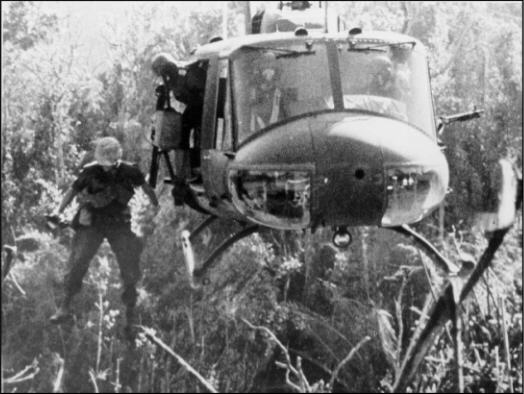
If the decision is made to use a hot LZ, or contact is made upon landing, troops quickly dismount and move 15 to 20 meters away from the aircraft and immediately return the enemy fire to allow the aircraft to depart. If the contact is similar to a far ambush, troops will fire and maneuver off the LZ to the closest side offering cover and concealment. If troops are engaged from nearby enemy positions, they treat it as a near ambush by immediately returning fire. Soldiers who consider themselves in the kill zone may assault the enemy positions or attempt to get out of the kill zone. Soldiers not in the kill zone will provide supporting fire to support the movement of troops in the kill zone. The squad or platoon leader will call for fire support if it is available. Once disengaged from the enemy force, the squad or platoon leader will move the unit to a covered and concealed position, account for personnel and equipment, and assess the situation as to whether or not the unit can continue the mission.
Assembly on cold LZ.
Upon unloading from the aircraft, the chalk leader (squad leader) will move the chalk to its predetermined locations using traveling overmatch movement techniques. All troops will move at a fast pace to the nearest concealed position. Once at the concealed assembly point, the chalk leader will make a quick count of personnel and equipment and then proceed with the mission.
SUMMARY
In discussing the Landing Plan, it all revolves around sequencing, timing, and location. They all must be right or the GTP will suffer. There is truly art and science in developing the Landing Plan. As we stressed: If you can’t get into the objective area then you can’t get to the objective! To build on this blinding glimpse of the obvious (BGO); you can’t land if you can’t fly to the landing zone. So simple, yet so challenging!
NEXT MONTH
The next article will cover the third of the five air assault plans—the air movement plan. Think about what would keep you up if you were an AATF or AMC commander trying to find a way to get to the LZ. The dilemma is similar to an amphibious landing commander and his naval counterparts who have to get to the beach. It sounds easy but requires detailed consideration since the force is most vulnerable when it’s in its delivery systems, on the move, and exposed.
